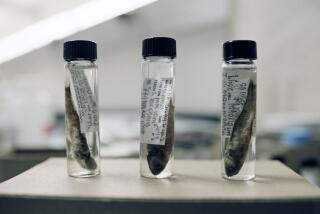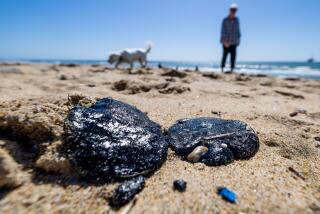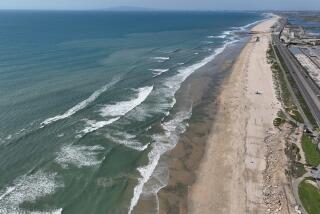Signs of oil spill pollution might be hiding underwater
Reporting from Los Angeles and Venice, La. â Biologist Dennis Takahashi-Kelso peered into the cobalt waters of the Gulf of Mexico 20 miles off the Louisiana coast. The only sign of pollution was a plastic bag floating beneath the surface.
More than three weeks after the Deepwater Horizon rig exploded, resulting in a leak spewing 210,000 gallons of crude per day into the gulf, the fouled beaches and dead seabirds that are the hallmarks of catastrophic spills have yet to materialize.
But Takahashi-Kelso, who was Alaskaâs commissioner of Environmental Conservation at the time of the Exxon Valdez disaster, warned: âItâs going to be bad.â
Even as the spill breaks into separate strands, a nasty environmental storm is brewing below the surface, in deep columns of water teeming with life, from shrimp and fish eggs to dolphins and whales.
Last week, researchers from the National Institute for Undersea Science and Technology reported on their website that they had found what they believe are large plumes of oil far beneath the surface.
Experts donât know what the oil is doing to the complex web of offshore life. Most of their experience is with shallow-water spills that quickly bleed black goo onto beaches that are cleaned up relatively quickly.
The BP well blowout, 48 miles off the Louisiana coast, is different. Oil is gushing from a tangled, broken pipe lying on the seafloor nearly a mile beneath the surface. The leak will be a month old this week, and if it is not stanched by then, it will have spilled about 6.3 million gallons.
âWe have no idea where the oil that isnât reaching the surface is going,â said James Cowan Jr., an oceanography professor at Louisiana State University. âIt could go everywhere.â
Tar balls have washed ashore in three Gulf Coast states, strips of slick ribboned Louisianaâs Chandeleur Islands, and the whiff of petroleum has permeated the morning breeze. But most fishermen and residents havenât seen any signs of the spill, aside from the media trucks parked in marinas and military helicopters whirring overhead.
They sit in dark bars and talk about possible solutions to the disaster, or fix parts of their boats, waiting for oil to reach land or go away.
âEverybodyâs just waiting,â said Daniel Camargo, who was hanging out with friends on his boat, the Christian Louis, moored on a canal in St. Bernard Parish, La. Red and yellow crab traps were stacked nearby, unused.
The rust-tinted light crude, meanwhile, sloshes around a part of the gulf that is a major pathway for marine life, where the nutrient-filled waters of the Mississippi River mix with the ocean.
âItâs a significant ecosystem that goes from the bottom to the top waters,â said Roger Zimmerman, a marine biologist who directs the Galveston Laboratory, part of the National Oceanic and Atmospheric Administrationâs Fisheries Service. âThis is a rich area in terms of biological productivity and diversity of animals. Thereâs a lot of reproduction.â
Red snapper, red drum, gulf menhaden and other fish use offshore waters east and west of the Mississippi Delta as nursery and spawning areas.
A big part of the countryâs commercial shrimp catch comes from the waters on either side of the undersea Mississippi Canyon, the site of the BP blowout. The canyon, which cuts through the continental shelf, harbors deep sea coral.
Pelicans and other seabirds that dive into the slick to catch prey will bathe in the oil and carry it back to their nests, where eggs can absorb it, possibly killing the chick developing inside. Sea turtles and dolphins, which surface twice a minute to breathe, will inhale harmful fumes as they swim through the slick.
âThis is such sticky oil in its emulsified and dispersed form that there are mechanisms of harm that we donât usually look at,â said Charles Peterson, a professor of marine sciences at the University of North Carolina who studied the effects of the 1989 Exxon Valdez spill on Alaskaâs Prince William Sound. The oil might clog the feeding organs of species such as jellyfish, he speculated.
What happens on the surface also affects the deep-sea creatures living far below, where they are nourished by the rain of plankton particles from above. âIf that productivity is eliminated or if itâs contaminated, all of that will go to the seafloor,â said Gilbert Rowe, a professor of oceanography and marine biology at Texas A&M.
The light nature of the crude spouting from the leak is both good and bad. Rather than the thick, viscous pancake of oil that Takahashi-Kelso remembers floating on the ocean in the Exxon Valdez spill, the BP oil is rising to the surface as a mousse.
That means it could decompose more quickly. But it also floats through the water in snow-like bits that increase exposure to the oilâs toxins. âThatâs all suspended in the water column where the organisms are found,â Peterson said.
âYou have real potential for long-term exposure to organisms, and that induces a very different mode of toxicity, whichâŚcan be very serious indeed,â he added. âThese chronic exposures affect the fitness of the organisms that are exposed. They donât necessarily kill outright but create organisms that are slow to react, often slow to grow.â
The widespread spraying of chemical dispersants on the surface slick may be compounding exposure and speeding oil uptake into the food chain, scientists warned.
The problem, said George Crozier, executive director of the Dauphin Island Sea Lab, is that it is easier for particle-munching microorganisms to ingest the broken-up bits of oil. âTheyâre not very discerning about what theyâre eating. They were less likely to chew on a big glob than if it was broken down to a particle size.â
Crozier described the marine community just below the surface as âremarkableâ in variety. It includes plankton, small animals and floating fish eggs and larvae â including those of commercially valuable red snapper and grouper.
Federal officials say the dispersants are a tradeoff. More than 500,000 gallons have been sprayed on the gulf so far, more than has ever been used in U.S. waters. And on Saturday, BP began releasing dispersants deep underwater, near the leak, after receiving Coast Guard approval. âWe didnât cross this threshold lightly,â said U.S. Coast Guard Rear Adm. Mary Landry. âThis is a tool that will be analyzed and monitored.â
Itâs not just the depth of the leak that distinguishes the Deepwater Horizon accident, but the size and duration.
âThe first few days I was willing to look at it as an episodic event, which ecosystems are pretty good at dealing with,â said Cowan of Louisiana State University. âBut the longer it goes, itâs quickly approaching a chronic stressor, which can be much more deleterious.
âA chronic stressor keeps pushing and pushing the system until it reaches a tipping point,â he explained. âIt may never recover to a state like it was previously.â
No one knows for sure how much crude the mangled riser pipe is disgorging into the gulf. Government and BP officials have estimated the daily flow at 210,000 gallons.
But officials and outside experts agree that estimating the flow rate is an inexact science. A Purdue University engineer who analyzed a video of the leak last week said the rate appeared to be in the range of 2.9 million gallons a day. That would mean more than 75 million gallons of oil have poured into gulf waters since the April 20 rig explosion, which left 11 workers missing and presumed dead.
The June 1979 Ixtoc I spill in Mexicoâs Bay of Campeche was bigger. By the time a blown-out well was capped nearly 10 months later, it had emptied 140 million gallons of oil into the gulf, according to the U.S. Interior Department. Within a couple of months after the blowout, a band of crude 30 to 50 feet wide coated South Texas beaches 700 miles north of the leak.
John âWesâ Tunnell, associate director of the Harte Research Institute for Gulf of Mexico Studies, studied the impacts of the Ixtoc I spill on the South Texas coast. Populations of worms and small crustaceans, food for shorebirds and small fish, plummeted by 80% in the intertidal zone and 55% in the surf zone.
âThe good news is that it recovered fairly quickly,â Tunnell said. âThe Gulf of Mexico is a very resilient place to have an oil spill,â he added, noting that every year the equivalent of one or two supertankers of oil leaks into gulf waters from natural seeps.
But the Ixtoc I blowout was in relatively shallow water, about 200 feet. Tunnell said little of the research on impacts closer to the wellhead was released by Mexicoâs state-owned petroleum company, Pemex. âSo we really donât know much about the studies they did.â
The flow of water through the gulf is so huge that the swirling BP spill mixture will eventually be replaced by clean water, said Rowe, of Texas A&M. In the meantime, a risky, unplanned experiment is underway.
âYou go back to the word âunprecedented,â â he said. âWeâre in a situation where the volume of the material, the concentration of the material, are in places where weâve never experienced them before. So we donât know what the effect is going to be.â
More to Read
Sign up for Essential California
The most important California stories and recommendations in your inbox every morning.
You may occasionally receive promotional content from the Los Angeles Times.











